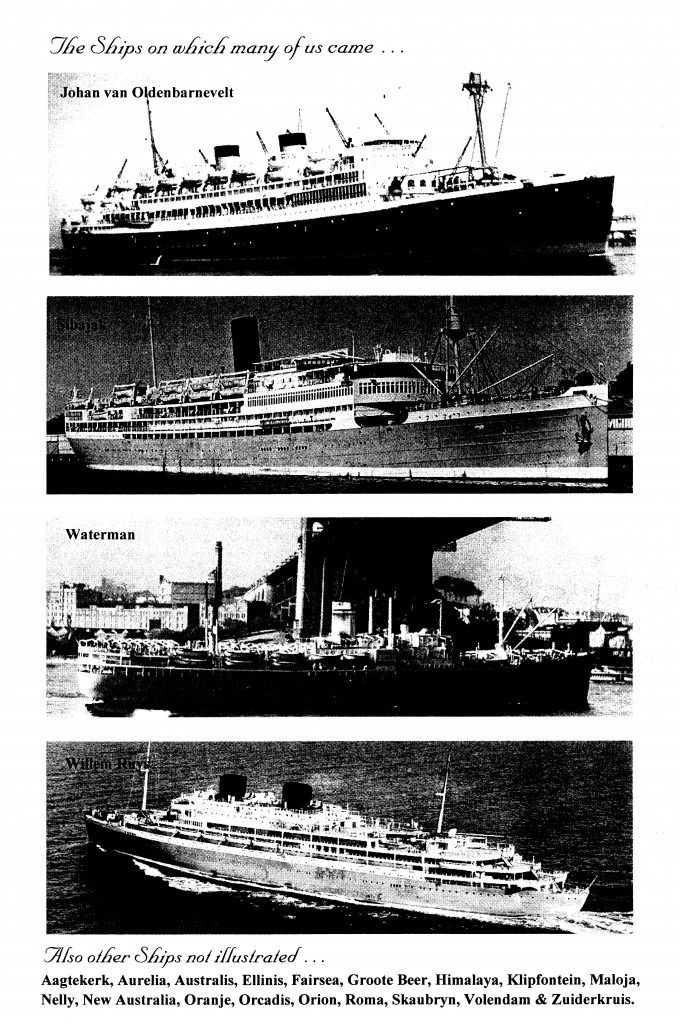More individual information is available on the DACC database (see links below).
The major ships bringing Dutch migrants to Australia include:
- De Groote Beer
- Johan van Oldenbarnevelt
- Volendam
- Nelly
- Nieuw Amsterdam
- Sibajak
- Skaubryn
- Waterman
- Zuiderkruis
- Willem Ruys


Remembering the Dutch Ships contribution for the defence of Australia.
Dutch passenger liners such as the MV Johan van Oldenbarnevelt, Oranje, Nieuw Amsterdam, and Volendam to name just a few were used to transport Australian troops to the Middle East and back during World War II. The ships were owned by the Netherlands’ largest shipping company, the Koninklijke Rotterdamsche Lloyd, and were requisitioned by the Dutch government-in-exile for use by the Allies.
The Oranje, in particular, was given to the Australian government as a fully manned hospital ship in 1940. It was one of two hospital ships used by the Australian military during World War II and was manned by a crew of Dutch and Australian personnel. The ship was used to transport wounded soldiers from the Middle East and New Guinea back to Australia for medical treatment. The ship had a capacity of 420 patients and was equipped with state-of-the-art medical facilities.
The other Dutch passenger liners were also used to transport troops, equipment, and supplies to and from the Middle East during the war. The ships played a crucial role in supporting Allied operations in the region and were often under threat from Japanese submarines and surface raiders while sailing through the Indian Ocean. The Johan van Oldenbarnevelt was even damaged by a Japanese mine in 1942, but managed to make it back to port for repairs.
By Keith Paulusse
Dutch Shipyards
Background information on the shipyards where among others the Dutch passenger ships were build.
Information with thanks to Ruud van der Sluis from the foundation Stichting NDSM-Herleeft
This organisation (NDSM lives on) focuses on bringing together, preserving, and presenting the history of the Nederlandsche Dok en Scheepsbouw Maatschappij (NDSM) in Amsterdam. NDSM was once the largest Dutch shipyard.
NDSM dates back to 1894, the year the Nederlandsche Scheepsbouw Maatschappij (NSM) was established. This took place on Oostenburg, one of the eastern Islands in Het IJ – formerly an estuary providing access first to the Zuiderzee and from 1876 via the Noordzee Kanaal directly to the Noth Sea. ‘Het IJ’ was situated right in the centre of Amsterdam. The establishment of this shipbuilding yard took place on the site where the shipyard of the Dutch East India Company was located until the end of the 18th century.
As ships, first made of iron and later of steel, became larger and more numerous, the yard became too small. The new Central Station in Amsterdam, located on the edge of the IJ, was now in the way. For this reason, the yard was gradually moved to the northern shore of the IJ in 1917. To the west of that, Tuindorp Oostzaan and the Nederlandsche Dok Maatschappij (NDM) would rise in 1921.
Due to war damage, NSM and NDM started working together in 1946, resulting in the formation of NDSM. NSM was a specific new-build yard, while NDM was mainly involved in ship repair and maintenance.
At NSM, many cargo-passenger and passenger ships were built. This was a logical consequence of owning our colonies. Flying was still far off and import and export were done by sea. On passenger ships, such as mail ships, luxury was often abundant.
One example is the Johan van Oldenbarnevelt, built by NSM. Initially, there were four classes on board. The higher up on the ship, the more expensive the ticket. This ship, along with its sister ship Marnix van Sint Aldegonde, was part of the fleet of the Stoomvaart Maatschappij “Nederland” (SMN), colloquially known as “the Nederland.” SMN was one of the three largest shipping companies in Amsterdam.
The life journey of “the Johan” was impressive. It survived the war and transported soldiers to and from the (then) Netherlands East Indies.
In the fifties, emigrants seeking a better future in other overseas countries, including Australia, traveled on it. Broadly speaking, this lasted for ten years. The last emigration voyage began on September 29, 1958, with voyage 48. In Australia, ports were visited in Fremantle, Melbourne, and Sydney in October and November. On the return journey, ports in Indonesia were also visited, and repatriates boarded.
In 1996, a book about this ship was published, titled “Johan van Oldenbarnevelt. A Ship with Six Lives.“
See also:
Steam Shipping Lines Australia – Netherlands – starting in 1864
Hospital ship Oranje looked after more than 30.000 wounded soldiers
Ondina: Shell’s Ondina tanker played a key role in WWII operating from Exmouth
Other Research information:
Passengers list: National Archive of Australia


